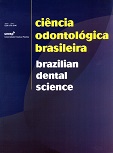Influence of additional polymerization in the microhardness of direct composite resins
DOI:
https://doi.org/10.14295/bds.2007.v10i2.333Abstract
Objective: To evaluate different methods of additional polymerization in the Vickers’ microhardness of three composite resins. Material and Methods: With assistance of a metallic matrix (3 x 4mm), 30 specimens (sps) of each direct resin composite (drc) were prepared, entitled: Filtek Z250(3M ESPE, Saint Paul/MN-USA)(Gr1), W3D(Wilcos, Petrópolis/ RJ-Brazil)(Gr2), and EstheticX (Dentsply/York/PA-USA)(Gr3). All sps were photopolimerized, by the incremental technique, during 40 seconds (Gr1 - n=10: control). After that, 20 samples of each group were divided and half of the samples (n=10) were submitted to the additional polymerization during 15 minutes to 127ºC in autoclave (Gr2) and the other half in stove (Gr3). After all sps were stored in distilled water (37ºC/24 hours). The microhardness was accomplished in digital machine (Future-Tech, FM 700 Model), with 50kg of load. The data obtained (Kg/mm2) were analyzed utilizing the ANOVA Test (2 factors) and Tukey test (p<0.05). Results: The values of mean ± standar deviations obtained were: Gr1a(84,2±5,1), Gr1b (71,6±6,7), Gr1c (89,6±7,4), Gr2a (101,1±6,0), Gr2b (96,4±9,0), Gr2c (112,6±7,3), Gr3a (74,0±6,5), Gr3b (66,0±12,7) e Gr3c (81,7±6,5). The polymerization in stove produced a higher microhardness than the other kinds of polymerization (p<0.05) and the microhardness of the resins statistically differed among them (p<0.05). Conclusion: The additional polymerization of the Filtek Z250 in the stove produced microhardness statistically higher than the others.Downloads
Downloads
Published
How to Cite
Issue
Section
License
Brazilian Dental Science uses the Creative Commons (CC-BY 4.0) license, thus preserving the integrity of articles in an open access environment. The journal allows the author to retain publishing rights without restrictions.
=================




























